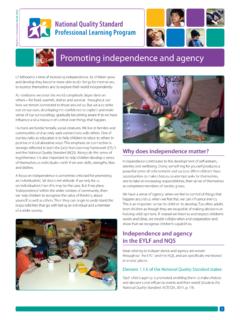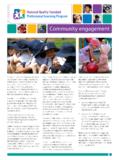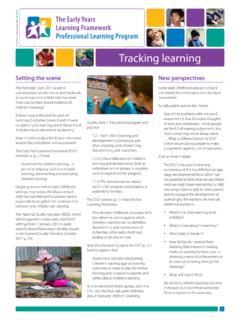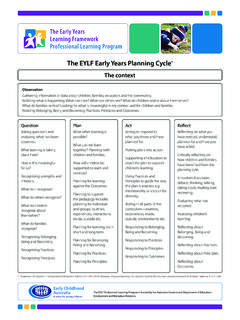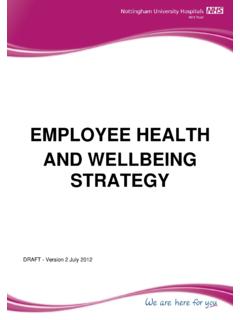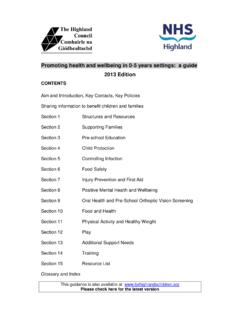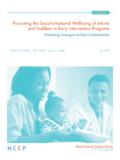Transcription of Health, safety and wellbeing - Early Childhood …
1 1 NQS PLP e-Newsletter No. 29 2012 health , safety and wellbeing Setting the sceneChildren s health and safety is about more than just their physical wellbeing ; it also refers to their whole welfare. This means that Early Childhood educators think about more than practical health and safety issues in their day-to-day work. They also recognise that children will have differing emotional support needs and therefore deal with each child differently, respecting their individual life Early Years Learning Framework (EYLF) (DEEWR, 2009a) identifies 'holistic approaches as one of the Principles of Early Childhood pedagogy that underpins practice:'When Early Childhood educators take a holistic approach they pay attention to children s physical, personal, social, emotional and spiritual wellbeing as well as cognitive aspects of learning ( ).
2 The introductory statement for Quality Area 2: Children s health and safety of the National Quality Standard (NQS) (DEEWR, 2009b) also highlights the importance of supporting children s health and safety in ways that focus on all aspects their wellbeing :'All children have the right to experience quality education and care in an environment that provides for their health and safety . This should be complemented by a focus on promoting each child s wellbeing and providing support for each child s growing competence, confidence and independence. (ACECQA, 2011, p. 50) wellbeing supports learningIn the Bugarri (three fives) room at Gowrie Child Care Centre, Erskineville, the educators respect children s individual sleep and rest requirements by providing three separate areas for sleeping, resting and quiet activities, and ensuring that children have access to calm and quiet areas throughout the day.
3 During rest time, there is an area that is available for children who will have a nap. Another area is provided for children who do not usually sleep, but would prefer to rest or draw or read quietly on their own. Children who do not usually require a sleep or rest can participate in focused or intentional planned small group activities, or guided relaxation with educators on the shaded verandah or other parts of the centre. Educators talk with families about individual children s needs and preferences for sleep and rest times. A strong sense of wellbeing is fundamentally connected to children s sense of belonging, being and becoming. When children feel well, happy, secure and socially successful they are able to fully participate in, and learn from, the daily routines, play, interactions and experiences in their Early Childhood setting.
4 Settings that promote children s wellbeing clearly include a focus on basic practices such as supervising children adequately, ensuring the safety of equipment and the environment, good hygiene and safe sleep procedures, managing illness and injuries effectively and meeting children s nutritional needs. They also allow flexibility to respond to individual lifestyles'Learning about healthy lifestyles, including nutrition and physical fitness, is integral to wellbeing and self-confidence. (DEEWR, 2009a, p. 30; ACECQA, 2011, p. 63)Learning about how to live in a healthy way, and being able to take increasing responsibility for making good health choices and caring for themselves, enables children to experience wellbeing in their present lives, and lays the foundation for a healthy lifestyle in the key part of learning about and adopting healthy lifestyles involves children seeing these modelled positively and enthusiastically by the important people in their lives, including their peers, families, communities and Early Childhood educators.
5 Learning about healthy lifestyles often occurs most effectively when educators identify and use the learning opportunities in everyday experiences such as meal times, hygiene procedures, active play times and toileting and emotional wellbeing Psychological wellbeing is as important as physical wellbeing to children s overall health status. The EYLF (p. 12) states that:'Educators who are attuned to children s thoughts and feelings, support the development of a strong sense of wellbeing . To build positive relationships with children, educators get to know each child within their life context, and they understand and respond to children s strengths, interests and abilities, as well as to their home and community experiences.
6 To get to know each child well, educators build positive, interactive partnerships with the child and with the other people in the child s life, such as their family, community and other professionals or support people who work with them. When children experience secure, supportive relationships, they feel respected and valued. This fosters the development of their self-confidence and their ability to act as independent agents in their personal care, and in the development and maintenance of At Gowrie Victoria, Docklands, the educators provide children with opportunities to exercise their independence at meal times from a young age. Children transition from sitting in high chairs as soon as they are developmentally ready, to sitting at a communal meal table with educators and other children, and they are supported to serve food and feed themselves.
7 Educators have introduced a progressive lunchtime schedule, where a meal table is made available for an extended period of time for small groups of children. The children choose to eat when they are hungry and ready, rather than being required to eat according to a regimented timetable. The normal indoor and outdoor program remains available during lunchtime and children can choose to finish an activity they are engaged in before coming to eat, or to return to it once they have finished their relationships with others. Children who become strong in their social and emotional wellbeing are resilient and confident learners; they are able to cope with day-to-day challenges and frustrations, and they are able to recognise and feel good about their own achievements and those of others.
8 EYLF Learning Outcomes 3 and 4 highlight the inherent connection between children experiencing 'a sense of security and sound wellbeing (p. 33) and their confidence and capacity to be active participants in and willing contributors to learning. Educators support this 'by acknowledging each child s cultural and social identity, and responding sensitively to their emotional states (p. 30). When children can see and feel that they and their family and community experiences are understood and valued in the Early Childhood setting, their feelings of belonging increase, which in turn supports them to become confident and involved learners. For example, through regular conversations with families and children, educators can find out about the patterns of food growing, preparation, eating and rituals within each family and their respective cultures, and include relevant resources in their programs, in collaboration with their local Alexandria Child Care Centre, a City of Sydney service located in Sydney s inner west, children plant, weed and water the edible plants and herbs in the service s herb and bush tucker garden.
9 The children help to harvest items from the garden, which are used for cooking experiences and in meals provided by the centre. The children at Gowrie Child Care Centre, Erskineville, also talk about healthy foods and eating as they select seeds to plant in the centre s vegetable patches and help to nurture and eventually harvest the plants. Educators also use these as natural opportunities to talk with children about washing their hands after working in the 'hands-on experience with nature builds children s confidence and interest in healthy lifestyles:3 Safe environmentsNQS Quality Area 2: Children s health and safety , encompasses children s physical health and comfort, healthy eating and physical activity and children s safety and protection from and safe environments protect children from harm and promote children s psychological wellbeing by allowing them to exercise their independence through making decisions and taking on new difficulty that many educators face is how to balance children s health and safety with giving them genuine opportunities to explore, experiment, predict and take managed risks.
10 This balance can be achieved when the physical environment is arranged so that it is a predictable, 'known quantity for children; where they can make decisions and do things for themselves, and experience success in doing so. It is important that educators demonstrate trust and respect for children s abilities to make sensible decisions and to keep challenges within their current capacities. Educators can then acknowledge children s achievements and support them to move forward when they experience difficulties, or do not immediately succeed in their undertaking. E-Newsletter 'Spaces for children , included a section on 'trusting children , and provided examples of some services that have begun to restore their trust in children s abilities to negotiate (and enjoy!)
